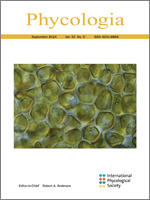Molecular-Assisted Alpha Taxonomy Genetic Testing Reveals Species of Red Algae


(PRWEB) November 19, 2014
Phycologia—The use of molecular-assisted alpha taxonomy (MAAT) has helped to distinguish species of the Bossiella genus of red algae. Whereas a morphological study showed four Bossiella species in the eastern Pacific Ocean, this genetic screening revealed 17 species groups. With genetic data and further morphological study, these groups could be identified, described, and named, or assigned to existing species.
A study in the current issue of Phycologia examines algae of the Corallinales order. Coralline algae have a high degree of phenotypic plasticity and morphological convergence in the marine environment, making them well-suited for this type of study. They are diverse in their forms, ranging from flat, smooth crusts on rocks to elaborate calcified fronds, and in their responses to physical parameters, such as depth and wave exposure.
Because these algae have made adjustments to their environments and followed individual but similar lines of development, genetic study is particularly useful in uncovering pseudocryptic species. MAAT uses molecular markers to assign collections to genetic groups. This is followed by detailed morphological observations to further define the species.
The last assessment of species within Bossiella was done prior to the use of DNA sequencing techniques. The current study used DNA sequences from three loci, including the DNA barcode marker mitochondrial cytochrome c oxidase subunit 1. In combination the sequence data led to the identification of the Bossiella species present in the northeast Pacific region.
Given the large number of species revealed, this study narrowed its focus to species with predominantly dichotomous branching, which encompasses the known morphospecies B. californica and B. orbigniana. Future studies will assess algae with pinnate or irregular branching.
Five species were found to be included among the dichotomous branching Bossiella:
B. californica, B. dichotoma, B. schmittii, Bossiella heteroforma sp. nov., and B. orbigniana. The B. orbigniana is the only species type that is not found in the northeast Pacific. Overall, these species were found to range from northern British Columbia, Canada, to Monterey Bay, California, United States; and two species reached Baja California, Mexico.
Full text of “Molecular-assisted alpha taxonomy reveals pseudocryptic diversity among species of Bossiella (Corallinales, Rhodophyta) in the eastern Pacific Ocean,” Phycologia, Vol. 53, No. 5, 2014, is now available.
###
About Phycologia
Phycologia, the journal of the International Phycological Society, is published bimonthly in English covering all aspects of algal biology: original research articles, major topical reviews, research notes, commentaries, book reviews, announcements of meetings and field courses and memorials of prominent phycologists. For more information, visit http://www.intphycsoc.org.